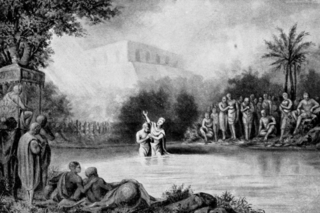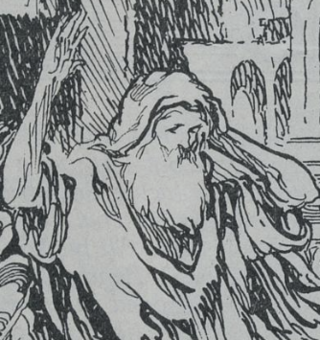
The Book of Helaman is one of the books that make up the Book of Mormon, a text held sacred by churches within the Latter Day Saint movement, including the Church of Jesus Christ of Latter-day Saints. The book continues the history of the Nephites and the Lamanites from approximately 50 BC to 1 BC. It discusses political unrest among the Nephites and the formation of a group of secret dissenters called the Gadianton Robbers. Helaman, son of Helaman leads the Nephites for a time, and his sons Nephi and Lehi go on a successful mission to the Lamanites. When Nephi returns home, he correctly identifies the murderer of the chief judge using his prophetic powers, and sends a famine to the Nephite which lasts three years. After a digression from Mormon, the book of Helaman ends with Samuel the Lamanite's prophecy of the signs that will precede Christ's birth and death. Helaman deals with themes of external and internal conflict, hidden information, Nephite racism, and Mormon's views of history as deduced by his redaction of it.
The Book of Mosiah is one of the books which make up the Book of Mormon. The title refers to Mosiah II, a king of the Nephites at Zarahemla. The book covers the time period between ca 130 BC and 91 BC, except for when the book has a flashback into the Record of Zeniff, which starts at ca 200 BC, according to footnotes. Aside from stating that it was abridged by Mormon, the text says nothing about its authorship. Mosiah is twenty-nine chapters long.

The Book of Mormon mentions three men named Helaman. The first was the son of King Benjamin, king of the united Nephite-Zarahemla kingdom who lived in the 2nd century BC. Besides his genealogy, information about the first Helaman is limited. His brother, Mosiah, became heir to the throne.

Zarahemla is a land in the Book of Mormon that for much of the narrative functions as the capital of the Nephites, their political and religious center. Zarahemla has been the namesake of multiple communities in the United States, has been alluded to in literature that references Mormonism, and has been portrayed in artwork depicting Book of Mormon content.

Alma is a Nephite prophet in the Book of Mormon. Initially a priest who serves in the court of King Noah, when a prophet named Abinadi preaches to the court Alma concurs with Abinadi and affirms that what the prophet said is true. For this, Noah banishes Alma and tries to have him killed. After leaving the court, Alma goes on to found a church among Noah's subjects. He eventually leads these churchgoers out from Noah's lands, through a sojourn under Lamanite rule, and to the land of Zarahemla, where their ancestors had come from a few generations earlier, where Alma becomes high priest of the Nephites' church.

King Noah is a Nephite king in the Book of Mormon who appears in the Book of Mosiah. Noah rules over a Nephite colony who came from Zarahemla and settled in the land of Lehi-Nephi, succeeding his father, Zeniff. In the Book of Mosiah, King Noah breaks away from his father's righteous teachings, committing "all manner of wickedness." Noah and his priests sentence the prophet Abinadi, who prophesied of his kingdom's downfall if they did not repent, to death by fire. During a Lamanite invasion, Noah and some of his people flee the land, and those who remain are subjected to Lamanite control. Noah attempts to forbid his men from returning to their families, and they burn him at the stake. Noah is succeeded by his son, Limhi.

In the Book of Mormon, Ammon is a prominent Nephite missionary and a son of King Mosiah. He originally opposes the church, but along with his brothers and Alma the Younger, is miraculously converted. Following his conversion he serves a mission to the Lamanites and converts Lamoni and his people.

Zeniff is a king in the Book of Mormon whose personal account is recorded in the Book of Mosiah. He is the father of King Noah and the grandfather of King Limhi. Zeniff is the first king of Nephite colonists who come from Zarahemla and settle in the land of Lehi-Nephi. The Nephites believe this land to be rightfully theirs by inheritance, even attempting to reclaim the land by force. In an expedition in which he spies for the Nephites, Zeniff claims to see good in the Lamanite inhabitants. He argues against a militaristic approach and causes an internal battle among the Nephite army. Zeniff later leads a group of Nephites back to Lehi-Nephi and establishes a peace treaty with the Lamanite king whose people inhabit the land. Zeniff’s people prosper with him as king, but the Lamanite king betrays their treaty and attempts to exploit them. Zeniff and his people successfully fight off the Lamanites’ multiple aggressions, and Zeniff's reign lasts about forty years, after which he passes the kingship to one of his sons, Noah. Scholarly interpretations have highlighted Zeniff's shifting perceptions of Lamanites, such as how his opinion changes when his people contends with the Lamanites and the role that Zeniff's narration plays in racializing Lamanites in the Book of Mormon.

In the Book of Mormon, Limhi is the third and final king of the second Nephite habitation of the land of Lehi-Nephi. He succeeds his father, Noah. Led by Ammon, Limhi and his people escape from the Lamanites with his people to the land of Zarahemla.

In the Book of Mormon, chapters 9 through 22 of the Book of Mosiah are identified as the Record of Zeniff. These chapters contain the story of a group of Nephites, led by Zeniff, who leave the land of Zarahemla and return to their former land, known as the land of Nephi, which was then occupied by the Lamanites, their traditional enemies. Although the attempt to establish themselves among the Lamanites is successful for a short time, the people of Zeniff are ultimately enslaved and forced to pay tribute to the Lamanite king. They are later rescued by an expedition from Zarahemla sent to discover their fate. The Record of Zeniff records the reigns of Zeniff, his son Noah and grandson Limhi. The timespan is approximately 75 years.

According to the Book of Mormon, the plates of Nephi, consisting of the large plates of Nephi and the small plates of Nephi, are a portion of the collection of inscribed metal plates which make up the record of the Nephites. This record was later abridged by Mormon and inscribed onto gold plates from which Joseph Smith translated the Book of Mormon after an angel revealed to him the location where the plates were buried on a hill called Cumorah near the town of Palmyra, New York.

According to the Book of Mormon, Moronihah was the son of Captain Moroni who had defeated the armies of Zerahemnah, stopped the king-men, and restored the Nephites' cities to their possession. When Moroni got too old to lead an army any longer, Moronihah received command of his father's armies.

In the Book of Mormon, Mosiah, King Benjamin's son and Mosiah I's grandson, is king of the Nephite nation from about 124 BC to 91 BC. The Book of Mosiah is named after Mosiah. Mosiah is also a prophet and is described by Ammon as a "seer" who can translate records.

In the Book of Mormon, Ammon is a Mulekite descendant and leader of a Nephite expedition from Zarahemla, sent to discover the fate of Zeniff and his people. Zeniff and his followers left Zarahemla and travelled to Nephi, their ancestral home, which was then in the possession of the Lamanites. This may have contributed to his expedition, not knowing the actual route to Nephi.

The Gadianton robbers, according to the Book of Mormon, were a secret criminal organization in ancient America.

The following outline is provided as an overview of and topical guide to the Book of Mormon:

According to the Book of Mormon, Coriantumr (/ˌkɒriˈæntəmər/) was a Nephite dissenter and Lamanite captain. Coriantumr led the Lamanite armies against the Nephites in an attempt to conquer the land. He was countered by Moronihah and Lehi, eventually dying in battle.






